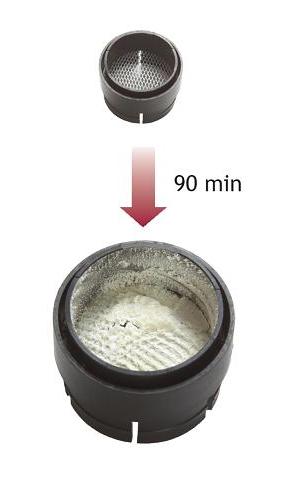Everyone working in an industrial environment comes in contact with chemicals containing various solvents. Chemical reactions and processes are occurring either as an essential requirement for, or as a consequence of, many seemingly physical work activities. The degree of hazard imposed by the chemicals and solvents depends upon the properties of the substances and the precautions taken when handling the substances. Due to the limited knowledge of occupational health risks and worker apprehension about reporting dangerous or suspect situations, very few employees understand the risks of exposure to hazardous substances.
Organic solvents are absorbed mainly through the mucous membranes but can also be absorbed through the skin and digestive system.
Gases have the ability to mix or diffuse with the air in a room. Diffusion (from Latin di = pull apart and fusion = spread) means the particles spread from an area of high concentration to an area of low concentration until all have the same relative spacing and position to one another (equilibrium is attained).
Additionally, in today’s society, we see a sharp increase in sensitivities to allergic materials (airborne particles, pets, solvents). The increased sensitivity increases the need for adequate air filtration and extraction equipment as well as increased precautions.
Why are solvents dangerous?
Solvents dissolve fat. The easier they dissolve fat, the easier they are absorbed by the body and the greater the capacity for affecting the nervous system. The ability to dissolve fat makes solvents useful in industry, but is one of the main reasons they are so dangerous if absorbed or ingested into the body.
Brain cells contain a lot of fat. Since the brain absorbs solvents much like a sponge, it makes exposure to solvents even more dangerous.
But can’t the body break down solvents?
Yes it can. The liver can break down many solvents ingested or absorbed into the body. Unfortunately, the chemicals formed when these substances are broken down can be even more dangerous than the original solvents. Also, the process of breaking down solvents can take a long time, so long that the body cannot get rid of everything overnight or even over a weekend. The solvents remain and continue to wreak their effects upon the body. Since most employees are not away from the work place long enough for the solvents to be completely removed by the liver, the amount of solvents in the organs continues to increase.
Are all solvents equally dangerous?
No, and some are not as easily absorbed by the body as others. If you must use a solvent, try to use one that has the least potential for harm.
There are many kinds of solvents that can harm the body (see below). Some of these solvents are used in manufacturing processes to form other products, and some are used with heat, humidity and in other environments that can transform them into even more dangerous materials.
What part of the body is harmed by the solvents?
That depends on the solvent in question. The brain, bone marrow, liver and kidneys are in the danger zone and are most likely to be affected. Damage to the nervous system is most common.
Generally, the nervous system is affected right away. As with over consumption of alcohol (which is a solvent), initial symptoms are slowed reactions and clumsiness. Judgment often becomes impaired, leading to additional job related risks.
It has been proven that occupational health symptoms appear over a long period and that solvents can cause lasting damage to the nervous system, respiratory system, eyes, brain, liver, and kidneys.
Solvents and their properties
Isocyanates
TDI (toluene-2.4-diisocyanate), MDI (diphenyl-methane diisocyanate), HDI (hexa-methylene diisocyanate).
Isocyanates can easily be absorbed through the skin and through the mucous membranes. In contact with water, they form amines which can stay in the blood for a long time. Isocyanates are found in polyurethane materials (coatings), glues, and varnishes.
Alcohols
Methanol, ethanol, isopropanol
Inhalation or contact with the skin can cause dizziness, headache, disturbed vision and fainting. Absorption over a longer period can reduce the eyesight of the victim.
Aldehydes
Formaldehyde, acetaldehyde
These solvents are created when heat is applied to rosin. The fumes have an irritating effect on the eyes and the respiratory organs. Inhalation can induce headache, dizziness, and fainting in severe cases.
Esters (acetate)
Ethyl acetate, dioctyl phthalate
These materials are often used as solvents and dissolvents in paints, plastics, and synthetic fibers. As with all solvents, they cause irritation of the respiratory passages and, with long term absorption, they cause damage to the kidneys and liver.
There are many other solvents on the market and in the work place including ketones, mercaptans, organic acids, and ethers, which have their own individual reactions to the human body. Most affect the respiratory system or cause eczema when coming in contact with the skin.
Occupational asthma
A very wide range of chemicals and biological agents have been described as causes of occupational asthma.
“Occupational asthma is a disease characterized by variable air flow limitation and/or airway hyper-responsiveness due to causes and conditions attributable to a particular occupational environment and not to stimuli encountered outside the workplace (Bernstein et al 1993)”
As the nose is part of the respiratory system, it should be kept in mind that asthma often is indicated by symptoms common to ‘hay-fever’, an itchy, blocked or runny nose, often red and accompanied by sneezes. The eyes may become ‘glazed, itchy, or running’.
Workers may be unaware of the possible relationship between their symptoms and their work. Prevention and fume extraction at the work center will provide an adequate solution and prevent dangerous fumes and gases from reaching their exposure limits. It has been shown that once employees have been sensitized to a substance, they will have severe reactions to airborne concentrations lower than the allowed exposure limits.
